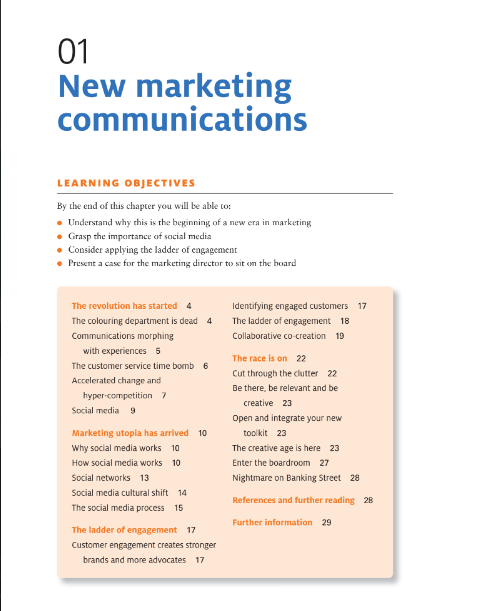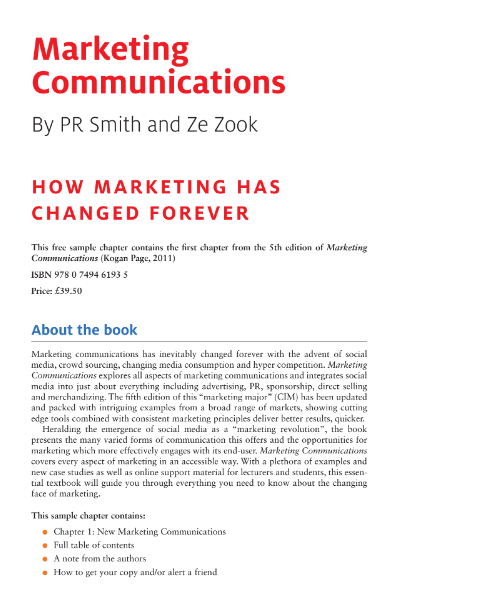


A new marketing era, long overdue, was heralded in when social media emerged as a real game changer. Social media put customers back at the centre of the organization and gave marketers a new set of tools to listen to them and to encourage them to engage with the brand. A golden opportunity has emerged as organizations realize the possibilities of engaging with customers in new ways so they can become partners driving the business forward. The ladder of engagement makes it easy to nurture customers up to higher levels of involvement. ‘Joined-up marketing’ brings the old ‘outbound marketing’ (eg advertising, direct mail, telemarket- ing, etc, sending out messages) together with inbound marketing (where social media brings conversa- tions to the organization). Integrating inbound and outbound with online and offl ine communications delivers higher impact and more cost-effective ‘joined-up marketing’. Marketing communications have to be integrated for two reasons. Firstly, unintegrated databases cause many problems and complications, as there is no single picture of the customer. Secondly, as com- munications morph into customer experiences, all communications need to be integrated to deliver a consistent experience. Amidst hyper-competition this ladder helps to build a ring fence of protection around the precious customer. It also encourages customers, and even non-customers, to collaborate and create anything from better promotions to better processes to better products. This marketing utopia is the beginning of a new creative age in marketing. It is also a new era of collaborative co-creation, which moves market- ing into a strategic position and earns its seat at the board. There is a golden opportunity for marketers to create stronger brands and sustainable competitive advantage and ultimately to build better businesses (or organizations). There has never been a better time to be involved in marketing. The colouring department is dead A lot of ‘old’ marketing has had too much emphasis on just marketing communications. This is a weak- ness.
Once upon a time this worked, as customers had far fewer communication channels and therefore it was easier to get a customer’s attention if marketers had the budget. And the big budget brands often announced ‘as seen on TV’ on their packaging, at point-of-sale and in their press advertisements. Being on TV gave the brand a level of credibility, perhaps because customers unconsciously assumed that being on TV meant that the company was a big company and big companies were trustworthy. Or perhaps customers trusted TV and the authorities that regu- late the advertisements that are allowed on TV. This may have led to communications strategies that told customers about product benefi ts. Today, marketing strategies ask ‘How will customers engage with us and each other?’ This leads to the bigger question ‘What kind of customer experience are marketers creating?’ This in turn brings marketers back to the quintessential marketing question: ‘How do we help customers?’ This is, for example, the ultimate reason why any company has a website. Yet many, if not most, marketers answer this ques- tion incorrectly.
Ask around and see. In fact, helping customers is the only reason a company exists, as American guru Peter Drucker used to say. These kinds of questions move marketers beyond communications, into customer experiences, customer relations, new product development processes, service processes and, of course, brand evaluation, which affects market capitalization. This, ultimately, invites marketers back into the boardroom, hopefully speak- ing the language of the board. Social media and the ladder of engagement, in particular, have opened the door to the boardroom for marketers.
customer experience. The search for added value is now relentless, whether through new features or more likely through enhanced web experiences, social media sharing or simply the addition of features to a pro- duct or service never dreamt possible before the arrival of the iPhone apps, eg Gibson Guitar’s app includes a guitar tuner, a metronome and a chord chart, all of which are extremely useful for any gui- tarist. Kraft’s iFood Assistant delivers recipes and a feature that creates a shopping list that automatic- ally includes the ingredients for the chosen recipes.
It even identifi es the locations of nearby grocery stores and which aisles stock the items. In fact Kraft Foods’ continued creative approach seems to have scored a hit for its Lacta chocolate bar in Greece by showing a long form of a long- form ad – a 27-minute branded-entertainment fi lm about love, made by many customers (see ‘The ladder of engagement’, page 18). Nike’s search to help customers led it to the Nike+ – a joint venture with Apple’s iPod that en- ables joggers to access a jogging community web- site, log their runs and connect with and compare to other joggers by using their iPods (or their iPhones) and a Nike+ branded transmitter that can be fi tted into some specially designed Nike shoes or attached to other running shoes. This is a far cry from just marketing communications, but it is all about help- ing customers and strengthening the brand and grow- ing revenues. Word-of-mouth marketing has become an ‘over-riding industry preoccupation for marketers as it provides a good measure of success (if customers endorse brands to their peers). Nike’s initiative has generated impressive results with Nike’s director of digital and content claiming “97 per cent of Nike+ users said they would recommend the service to a friend.
That fi gure is unheard of” ’ ( Grande, 2007 ). Think of ‘4Es instead of 4Ps’ ( Rothery, 2008 ) from the old marketing mix. A product is an experience (including online), place becomes everyplace, price becomes exchange and promotion becomes evange- lism. Alternatively, promotion is morphing with pro- duct as communications seek to engage customers with experiences.


